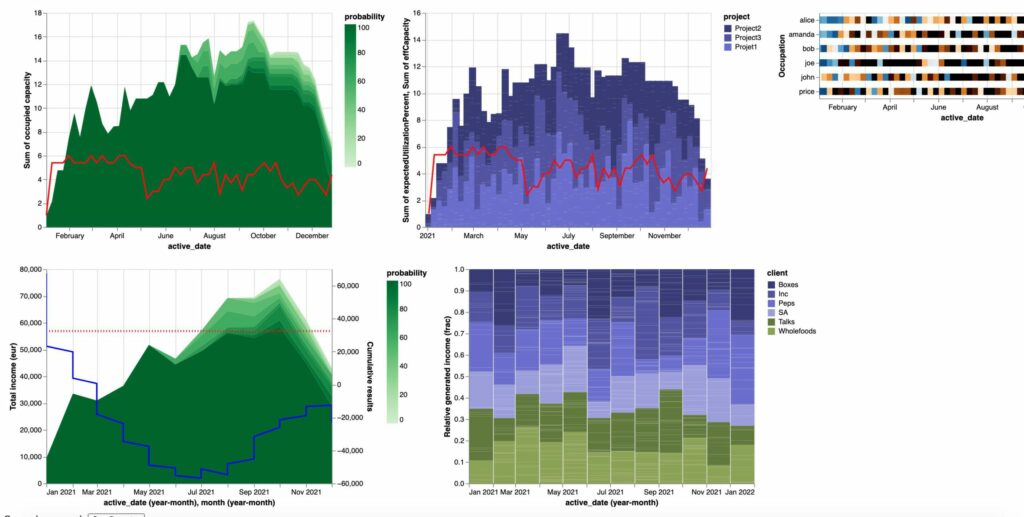Dribia describe themselves as a “data innovation studio.” And for the past 4 years, this rapidly expanding Barcelona-based company has been helping their clients build on-demand solutions using artificial intelligence and data science.
In their quest to improve upon their own workflow, they came across Ganttic’s online resource planner. Coupled with a custom-built API client made in Python and with the help of Ganttic API, Dribia were able to create their own customized solution to organize and visualize their planning process.
Read on to see how Dribia were able to cut their weekly planning time in half and how Ganttic API can help users develop their own unique workflows.
Barcelona, Spain
dribia.com
The Challenge
“Today we’re 20 people, but tomorrow we might be 50. We needed a clear plan of what was coming next”
Oleguer Sagarra
Dribia’s vision is simple. They seek to solve problems with data.
With a team of researchers and scientists, they are a diverse mix of creative, academic, and technical backgrounds. To make their motto of “data science within your reach” come true, they work closely with their clients to develop unique data strategies. As well as building tailor-made solutions with artificial intelligence to understand, predict, and optimize business processes.
 Image used courtesy of Dribia
Image used courtesy of Dribia
But for a company that prides itself on automating as many processes as possible for clients, it was frustrating to leave their own planning and forecasting to outdated tools such as Excel. Which as a resource planner, was becoming messy and untenable. Especially once the number of Dribia’s team members and projects began to grow.
So it was at that point that co-CEO and co-founder Oleguer Sagarra decided to take the necessary steps to improve their own organizational workflow.
“We essentially sell hours,” notes Sagarra about their business model. “So as to ensure that employees aren’t burnt out, while at the same time making sure no one is doing too little, we needed a way to track our resources and projects against our work hours.”
Believing in a “one tool for a single purpose” rule they quickly discounted “one size fits all” solutions. And with little need for all the complicated components of an ERP, they turned instead to a simple, streamlined tool that could be customized exactly to their needs.
The Solution
Ganttic was shortlisted and quickly implemented by the team as their resource management solution. And straight away there were 3 things that Dribia liked about the software.
- It was easy to understand.
- It was easy to use and intuitive to figure out.
- It had what they needed (custom data fields, project and resource overviews) without anything extra.
Plus, as an additional bonus, the price was reasonable. Because as Sagarra pointed out, “there’s lots of great solutions that do lots of complex things, but they also cost an absurd amount of money. And come with extra features we weren’t looking for.”
After about a year of use, Dribia was happy with their workflow. Every Monday, their HRO – human resources officer – logged in to their CRM, checked their prospects, and defined their projects and team in Ganttic. Using both public and private views, everyone could see what their duties were for the week.
 Image used courtesy of Dribia
Image used courtesy of Dribia
However, due to the nature of their business, they realized there were some opportunities for improvement. Because Dribia’s workforce needs to be highly skilled, it takes time to train new employees, anywhere from 1-2 months after they start working. This means that human resources need to be planned far in advance. But since their business model is project-based, it can be hard to predict exactly the amount of work they will have in the future.
Dribia needed a way to not only work with confirmed projects, but unconfirmed projects as well. For the data scientists this meant assigning potential projects a probability.
Yet, even after experimenting with Ganttic’s custom data fields, (which proved useful for other purposes) nothing was giving the Dribia team the hard data they needed for their forecasts. So they tried a different approach.
The Result
“We cut our planning time by half, 30% after we started using Ganttic and 50% once we implemented our own API client.”
In order to plan according to their needs, Dribia designed and implemented an API in Python. With this in place, they linked it to their planner through Ganttic’s API. This allowed them to assign a probability to their projects. Dribia’s API client would grab this data, then the data scientists would clean it up with their scripts. With this info they could finally generate custom visualizations off the platform. As Sagarra noted:
“Ganttic’s visualizations of data are really good, but the visualizations that we are doing are separate, because of the unknown of the probability. Plus, we are much more comfortable working with raw data,”
With Dribia’s API client in place, they are able to generate 4 different types of visualizations:
- One that tells them the top capacity and the expected occupation of resources.
- Another that forecasts expected income, factoring in the assigned probabilities to each project.
- One that shows whether their people are occupied or not, which they admit is something Ganttic already does, but in their version they can customize it more to their needs.
- And finally one which shows what percent of the work belongs to each client.
Commenting on the ease of Ganttic’s API, Sagarra had this to add, “Ganttic is easy, so that’s nice. And also the documentation is well written. So if anyone has experience with Rest API, then it’s not hard to follow.”
 Example of visualizations created by Dribia’s custom API client
Example of visualizations created by Dribia’s custom API client
Wrapping Up
The combination of Dribia’s API client and Ganttic has given the data scientists the ability to design their ideal solution with custom visualizations. While simultaneously cutting their planning time down from 4 hours a week to 2.
If you’re interested in learning more about Dribia’s API client, here’s the repository and here’s the documentation.
See if Ganttic’s API will work for your team and workflow. You can find our documentation here. And in our blog you’ll find some background about the specific features and functions you can get out of the API. Or see how resource management can transform your ICT organization.
To find out more about Dribia and the work they do, visit their website: https://www.dribia.com/